Wagner ProCoat Max User Manual

PROCOAT
MAX™
 Owner’s Manual
Owner’s Manual
Read this manual for complete instructions
Français (page 25) / Español (página 49)
Contents
2 |
Important Safety Information |
14 |
Clean the Inlet Filter |
4 |
What’s in the Box? |
15 |
Short Term Storage |
5 |
Proper Use and Functions |
16 |
Cleanup - latex materials |
6 |
Assembly |
18 |
Cleanup - oil-based materials |
7 |
Pressure Relief Procedure |
19 |
Cleaning the Spray Gun Components |
8 |
Load Material |
20 |
Long-Term Storage |
9 |
Getting Material to Flow |
21 |
Replacing the Outlet/Inlet Valves |
10 |
Practice Spraying |
22 |
Troubleshooting |
12 |
Clear the Spray Tip |
72 |
Parts List |
13 |
Clean the Spray Gun Filter |
76 |
Warranty |
Questions?
Call Wagner Technical Service at:
1-800-328-8251
Register your product online at:
www.wagnerspraytech.com
Proper registration will serve as proof of purchase in the event your original receipt becomes misplaced or lost.
0811 • Form No. 0504603B
Español Français English
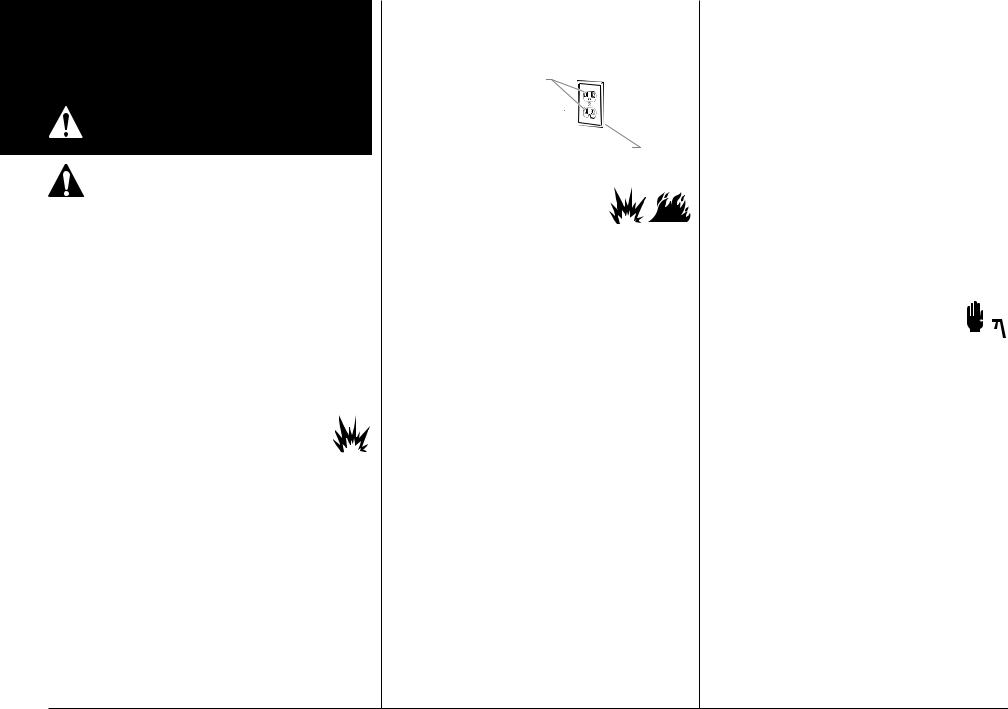
ImportantSafety Safety
Information
Read all safety information before operating
the equipment. Save these instructions
Indicates a hazardous situation which, if not avoided, could result in death or serious injury.
a)To reduce the risks of fire or explosion, electrical shock and the injury to persons, read and understand all instructions included in this manual. Be familiar with the controls and proper usage of the equipment.
Grounding Instructions
This product must be grounded. In the event of an electrical short circuit, grounding reduces the risk of electric shock by providing an escape wire for the electric current. This
product is equipped with a cord having a grounding wire with an appropriate grounding plug. The plug must be plugged into an outlet that is properly installed and grounded in accordance with all local codes and ordinances.
warning - Improper installation of the grounding plug can result in a risk of electric shock.
If repair or replacement of the cord or plug is necessary, do not connect the green grounding wire to either flat blade terminal. The wire with insulation having a green outer surface with or without yellow stripes is the grounding wire and must be connected to the grounding pin.
Check with a qualified electrician or serviceman if the grounding instructions are not completely understood, or if you are in doubt as to whether the product is properly grounded. Do not modify the plug provided. If the plug will not fit the outlet, have the proper outlet installed by a qualified electrician.
This product is for use on a nominal 120 volt circuit and has a grounding plug that looks like the plug illustrated below. Make sure that the product is connected to an outlet having the same configuration as the plug. No adapter should be used with this product.
Grounded Outlet
Grounding Pin
Cover for grounded outlet box
b) WARNING - To reduce the risk of fire or explosion:
1.Do not spray flammable or
combustible materials near an open flame, pilot lights or sources of ignition such as hot objects, cigarettes, motors, electrical equipment and electrical appliances. Avoid creating sparks from connecting and disconnecting power cords.
2.Do not spray or clean with liquids having a flash point of less than 21ºC (69.8ºF). Flash point is the temperature at which a fluid can produce enough vapor to ignite.
3.Paint or solvent flowing through the equipment is able to result in static electricity. Static electricity creates a risk of fire or explosion in the presence of paint or solvent fumes. All parts of the spray system, including the pump, hose assembly, spray gun and objects in and around the spray area shall be properly grounded to protect against static discharge and sparks. Use only conductive or
grounded high-pressure airless paint sprayer hoses specified by the manufacturer.
4.Verify that all containers and collection systems are grounded to prevent static discharge.
5.Connect to a grounded outlet and use grounded extension cords (electric models only). Do not use a 3 to 2 adapter.
6.Do not use a paint or solvent containing halogenated hydrocarbons. Such as chlorine, bleach mildewcide, methylene chloride and trichloroethane. They are not compatible with aluminum. Contact the coating supplier about compatibility of material with aluminum.
7.Keep spray area well ventilated. Keep a good supply of fresh air moving through the area to keep the air within the spray area free from accumulation of flammable vapors. Keep pump assembly in well ventilated area. Do not spray pump assembly.
8.Do not smoke in the spray area.
9.Do not operate light switches, engines, or similar spark producing products in the spray area.
10.Keep area clean and free of paint or solvent containers, rags, and other flammable materials.
11.Know the contents of the paint and solvents being sprayed. Read all Material Safety Data Sheets (MSDS) and container labels provided with the paints and solvents. Follow the paint and solvent manufacture’s safety instructions.
12.Place pump at least 25 feet (7.62 meters) from the spray object in a well ventilated area (add more hose if necessary). Flammable vapors are often heavier than air. Floor area must be extremely well ventilated. The pump contains arcing parts that emit sparks and can ignite vapors.
13.Plastic can cause static sparks. Never hang plastic to enclose spray area. Do not use plastic drop cloths when spraying flammable material.
14.Fire extinguisher equipment shall be present and working.
c)WARNING - To reduce the risk of skin injection: 
1.Do not aim the gun at, or spray any person or animal.
2.Keep hands and other body parts away from the discharge. For example, do not try to stop leaks with any part of the body.
3.Always use the nozzle tip guard. Do not spray without the nozzle tip guard in place.
4.Only use a nozzle tip specified by the manufacturer.
5.Use caution when cleaning and changing nozzle tips. In the case where the nozzle tip clogs while spraying, ALWAYS lock gun trigger, shut pump off, and release all pressure before servicing, cleaning tip or guard, or changing tip. Pressure will not be released by turning off the motor. The PRIME/SPRAY valve or pressure bleed valve must be turned to their appropriate positions to relieve system pressure. Refer to PRESSURE RELIEF PROCEDURE described in the pump manual.
6.Do not leave the unit energized or under pressure while unattended. When the unit is not in use, turn off the unit and relieve the pressure in accordance with the manufacturer’s instructions.
7.High-pressure spray is able to inject toxins into the body and cause serious bodily injury. In the event that injection occurs, seek medical attention immediately.
English |
2 |
|
|
|
|
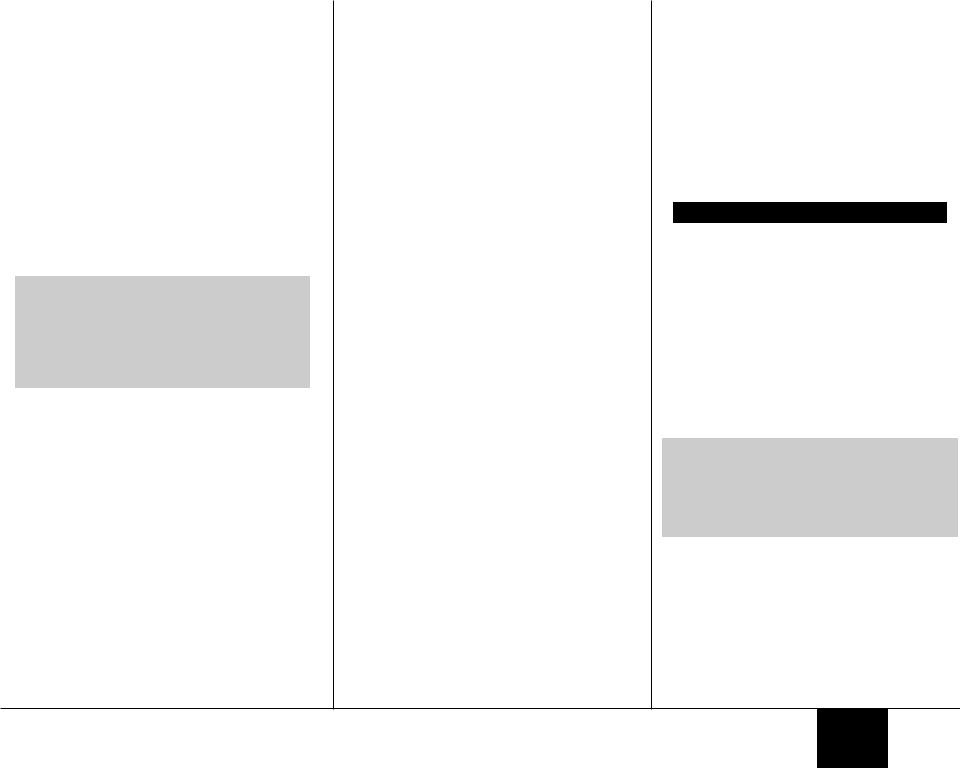
8.Check hoses and parts for signs of damage, a leak can inject material into the skin. Inspect hose before each use. Replace any damaged hoses or parts.
9.This system is capable of producing 2800 PSI / 193 Bar. Only use replacement parts or accessories that are specified by the manufacturer and that are rated a minimum of 2800 PSI. This includes spray tips, nozzle guards, guns, extensions, fittings, and hose.
10.Always engage the trigger lock when not spraying. Verify the trigger lock is functioning properly.
11.Verify that all connections are secure before operating the unit.
12.Know how to stop the unit and bleed pressure quickly. Be thoroughly familiar with the controls. Pressure will not be released by turning off the motor. The PRIME/ SPRAY valve or pressure bleed valve must be turned to their appropriate positions to relieve system pressure. Refer to PRESSURE RELIEF PROCEDURE described in the pump manual.
13.Always remove the spray tip before flushing or cleaning the system.
NOTE TO PHYSICIAN:
Injection into the skin is a traumatic injury. It is important to treat the injury as soon as possible.
DO NOT delay treatment to research toxicity. Toxicity is a concern with some coatings injected directly into the blood stream. Consultation with a plastic surgeon or reconstructive hand surgeon may be advisable.
d) WARNING - To reduce the risk of injury:
1.Always wear appropriate gloves, eye protection, clothing and a respirator or mask when painting. Hazardous vapors – Paints, solvents, insecticides, and other materials can be harmful if inhaled or come in contact with body. Vapors can cause severe nausea, fainting or poisoning.
2.Do not operate or spray near children. Keep children away from equipment at all times.
3.Do not overreach or stand on an unstable support. Keep effective footing and balance at all times.
4.Stay alert and watch what you are doing.
5.Do not operate the unit when fatigued or under the influence of drugs or alcohol.
6.Do not kink or over-bend the hose. Airless hose can develop leaks from wear, kinking and abuse. A leak can inject material into the skin.
7.Do not expose the hose to temperatures or pressures in excess of those specified by manufacturer.
8.Do not use the hose as a strength member to pull or lift the equipment.
9.Use lowest possible pressure to flush equipment.
10.Follow all appropriate local, state and national codes governing ventilation, fire prevention and operation.
11.The United States Government Safety Standards have been adopted under the Occupational Safety and Health Act (OSHA). These standards,
particularly part 1910 of the General Standards and part 1926 of the Construction Standards should be consulted.
12.Before each use, check all hoses for cuts, leaks, abrasion or bulging of cover. Check for damage or movement of couplings. Immediately replace hose if any of those conditions exist. Never repair a paint hose. Replace with a conductive high-pressure hose.
13.Do not spray outdoors on windy days.
14.Always unplug cord from outlet before working on equipment (electric models only).
Important Electrical Information
important: Use only a 3-wire extension cord that has a 3-blade grounding plug and a 3-slot receptacle that will accept the plug on the product. Make sure your extension cord is in good condition. When using an extension cord, be sure to use one heavy enough to carry the current your product will draw. An undersized cord will cause a drop in line voltage resulting in loss of power and overheating. A 14
or 12 gauge cord is recommended (see chart). If an extension cord is to be used outdoors, it must be marked with the suffix W-A after the cord type designation. For example, a designation of SJTW-A would indicate that the cord would be appropriate for outdoor use.
Cord gauge |
Maximum cord length |
12 |
150 feet |
14 |
100 feet |
Wagner Spray Tech accessory extension cords recommended:
P/N 0090241 20 foot extension cord P/N 0090242 35 foot extension cord
Do not use more than 50 feet of spray hose. If you need to spray further than 50 feet away from your power source, use more extension cord, not more spray hose.
If you experience problems with your sprayer at any time during assembly, operation, or cleanup, please refer to the Troubleshooting section of this manual (page 22), or call customer service at:
1-800-328-8251
3 |
English |
|
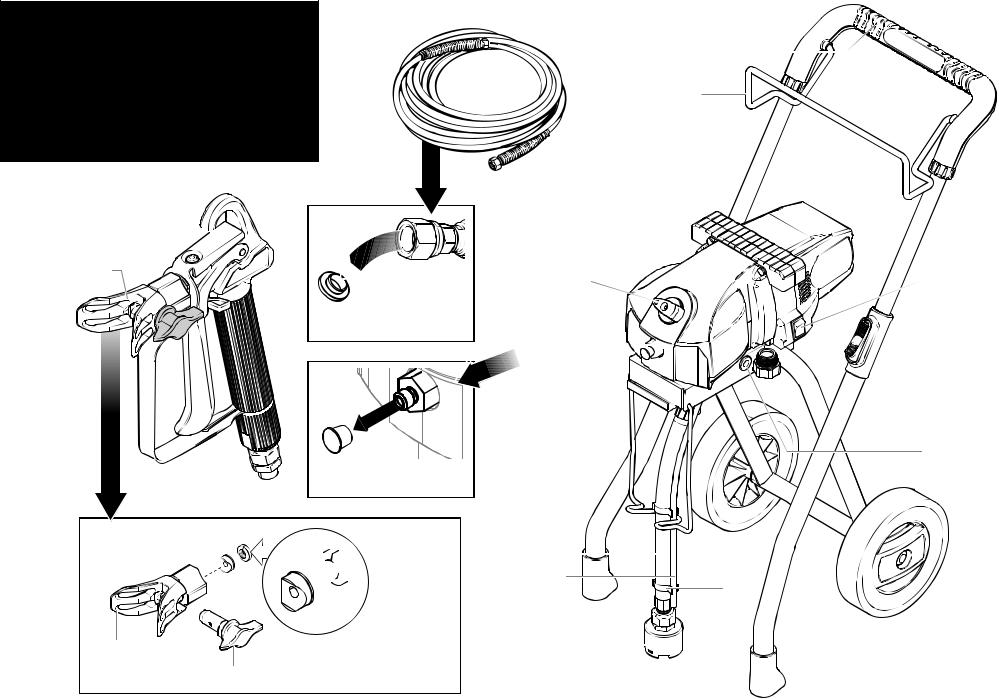
What’s in the box?
*Certain parts of the sprayer will not be assembled out of the box. Be sure to read Assembly instructions, page 6.
Spray Gun
Spray gun 


Spray tip assembly
Spray Hose |
Sprayer Assembly |
|
Handle |
(comes assembled |
Spray hose |
to the spray gun) |
|
|
holder |
 Cart
Cart
Remove the plug from inside the hose fitting. Discard.
Remove the cap on the spray hose outlet. Discard.
PRIME/SPRAY
knob
Spray hose 


 outlet
outlet 

Pail bracket  (five-gallon container)
(five-gallon container)
Pail bracket  (one-gallon
(one-gallon
container)
ON / OFF switch



 Cart
Cart
button (2)
 Pump cleaning adapter
Pump cleaning adapter
Spray tip storage area
Spray Tip Assembly
Spray
guard


 Washer**
Washer**
 Saddle seat**
Saddle seat**
** Saddle seat and washer Spray tip come pre-assembled inside
spray guard
Suction tube |
|
Material |
Clip |
return tube |
|
Inlet filter |
|
|
English |
4 |
|
|
|
|
|
|
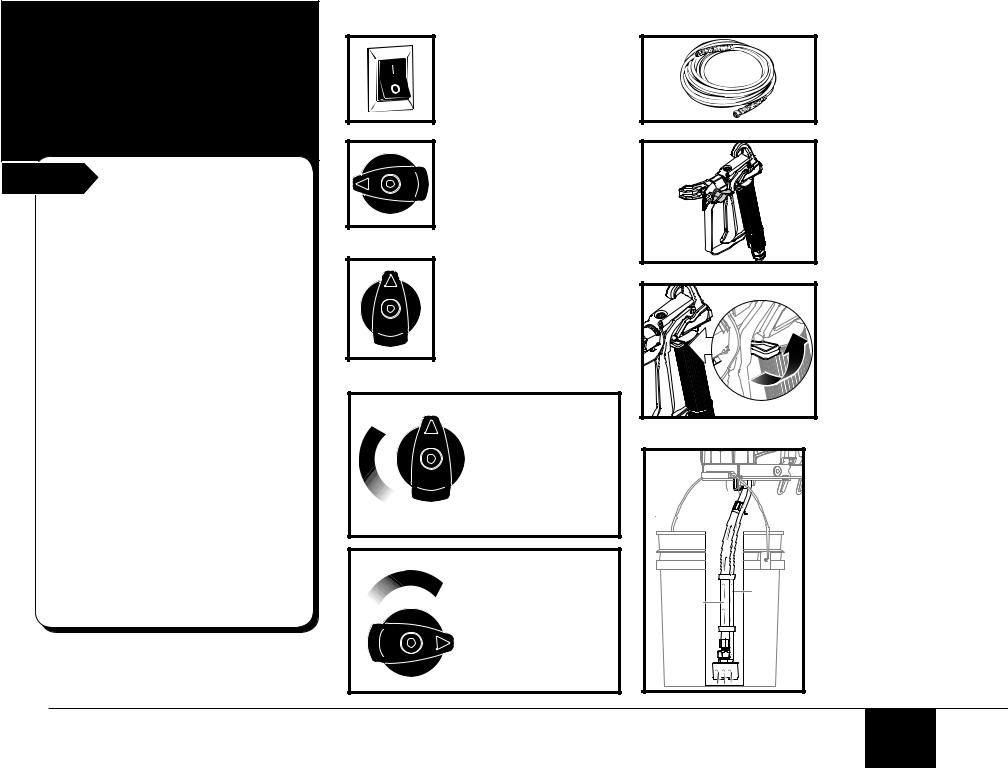
Proper use and functions
Start Capability:
Sprays a variety of paints (oil-based and latex), primers, stains, preservatives and other nonabrasive materials. Do not use materials with flash points below 70° F (21° C)
Do not use!
This pump should not be used with textured materials, block filler, lacquers, industrial enamels, or asphalt sealer or materials containing HHC. See coating supplier if flash point is not listed on the container
Safety features:
Spray gun trigger lock and pressure diffuser; built-in tip safety guard; PRIME/SPRAY knob for safe pressure release. Conforms to ULSTD
1450. Certified to CAN/CSAC 22.2 NO 68-92
Specifications
Weight |
28.5 lbs |
|
Flow rate |
0.24 gal/minute |
|
Power source |
1/2 Hp universal |
|
|
motor |
|
Power requirement |
15 amp minimum |
|
|
circuit on 120 VAC, |
|
|
60 Hz current |
|
Generator requirement |
5000 |
Watt |
Max. spraying pressure |
2800 |
PSI |
Controls and Functions
ON/OFF switch:
The ON/OFF switch turns power to sprayer on and off.
(O=OFF, |=ON)
PRIME/SPRAY knob:
The PRIME/SPRAY knob directs material to the material return tube when set to PRIME or to spray hose when set to SPRAY.
Pressure control:
The pressure control function is also controlled by the PRIME/ SPRAY knob. The pressure control regulates the amount of force the pump uses to push
the fluid and can be adjusted for desired spray pattern.
spray - minimum
pressure
Ideal for thinner spray materials.
Also to be used during cleanup, when unclogging the tip, or
when using the optional roller attachment.
spray - maximum
pressure
Ideal when spraying thicker materials.
To be used during spraying.
(a) |
(b) |
|
Spray hose:
The spray hose connects the spray gun to the pump.
Spray gun:
The spray gun controls the delivery of the material being pumped.
Trigger lock:
Engage the trigger lock whenever the gun is not in use.
The gun is locked when the trigger lock is at a 90º angle (perpendicular to the trigger in either direction).
Material return tube (a):
Fluid is sent out through the return tube and back into the original container when the PRIME/SPRAY knob is in the PRIME position.
Suction tube (b):
The suction tube draws the fluid from the original container into the pump.
5 |
English |
|
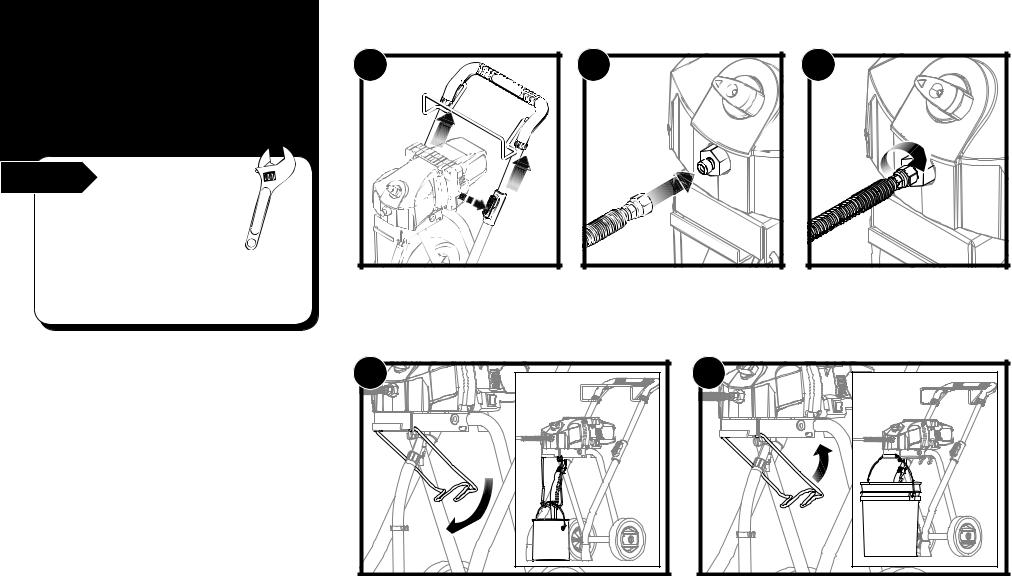
1. Assembly |
Start |
You will need: |
• Adjustable wrench
important: Do not plug in the power cord until assembly is complete.
Note: It will be much easier to attach the hose to the sprayer if you uncoil it first.
1 |
1.To extend the cart handle, push the two cart buttons and pull the handle out until it locks into place.
2 |
2.Thread one end of the spray hose to the outlet valve on the sprayer.
3 |
3.Tighten the hose with an adjustable wrench.
4 |
5.One gallon setup -
Swing the 1-gallon pail bracket toward the front of the sprayer. Hook the material container on the pail bracket.
5 |
6.Five-gallon setup -
Swing the 1-gallon pail bracket toward the rear of the sprayer until it is secured as shown. Hook the 5-gallon container onto the 5-gallon pail bracket as shown.
|
English |
6 |
|
|
|
|
|
|

Pressure Relief Procedure*
*Perform when instructed
Start |
Important Safety |
|
Warning |
Be sure to follow the Pressure Relief Procedure when shutting the unit off for any purpose. This procedure is used to relieve pressure from the spray hose. Failure to do so could result in serious injury.
You will need:
• A waste bucket
Important Safety Warning
Be careful when handling the spray gun so you don’t accidently spray yourself. The high pressure paint stream could pierce your skin causing serious injury. If an accident happens see detail procedures in the Safety Information section on pages 2-3. See physician immediately and bring this instruction manual.
1 |
2 |
|
|
OFF |
O |
1. Lock the spray gun trigger. 2. Turn the power OFF.
3 |
4 |
PRIM
3. Turn the PRIME/SPRAY knob to PRIME. |
4. Unlock the spray gun. Briefly pull the |
|
trigger to fully relieve pressure from the |
|
system. Lock the spray gun. |
7 |
English |
|
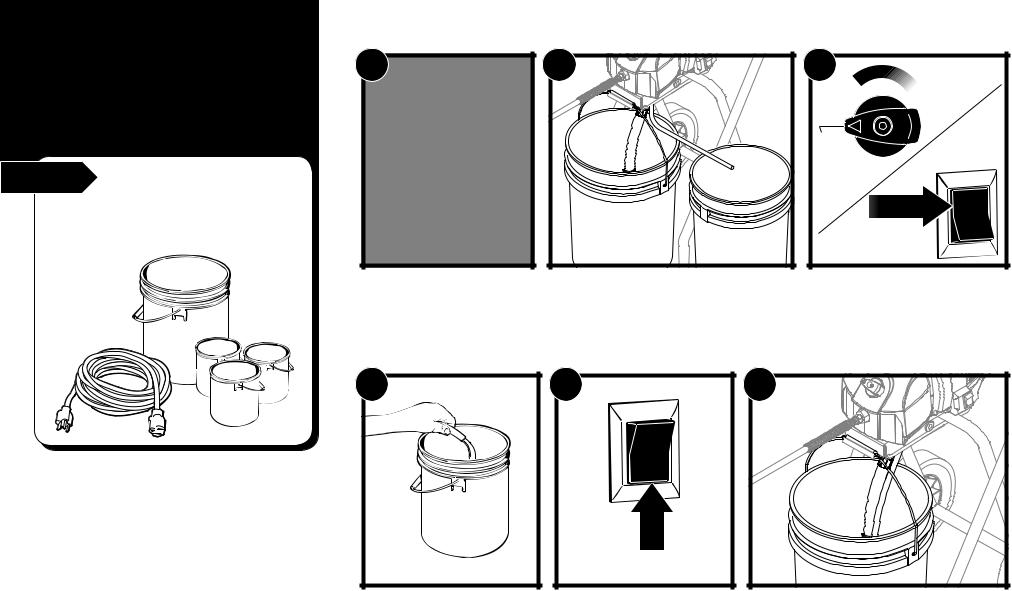
2. Load
Material
Start |
You will need: |
•The material you plan to spray
•Extension cord
•Waste bucket
1
1.Push the red inlet release button to ensure proper inlet valve operation.
4
4.Hold return tube over waste bucket until material is flowing (approximately five seconds).
2 |
(a) |
(b) |
2.Unclip the suction hose and return tube. Place suction hose into material container (a). Place return tube into a waste bucket (b).
3 |
|
PRIME |
|
ON |
l |
|
3.Plug in the sprayer. Turn the PRIME/SPRAY knob to PRIME. Turn the power ON.
5 |
|
6 |
|
O |
|
|
OFF |
|
5. |
Turn power OFF. |
6. Place return tube into material |
|
|
container and clip tube and |
|
|
suction hose together. |
|
English |
8 |
|
|
|
|
|
|
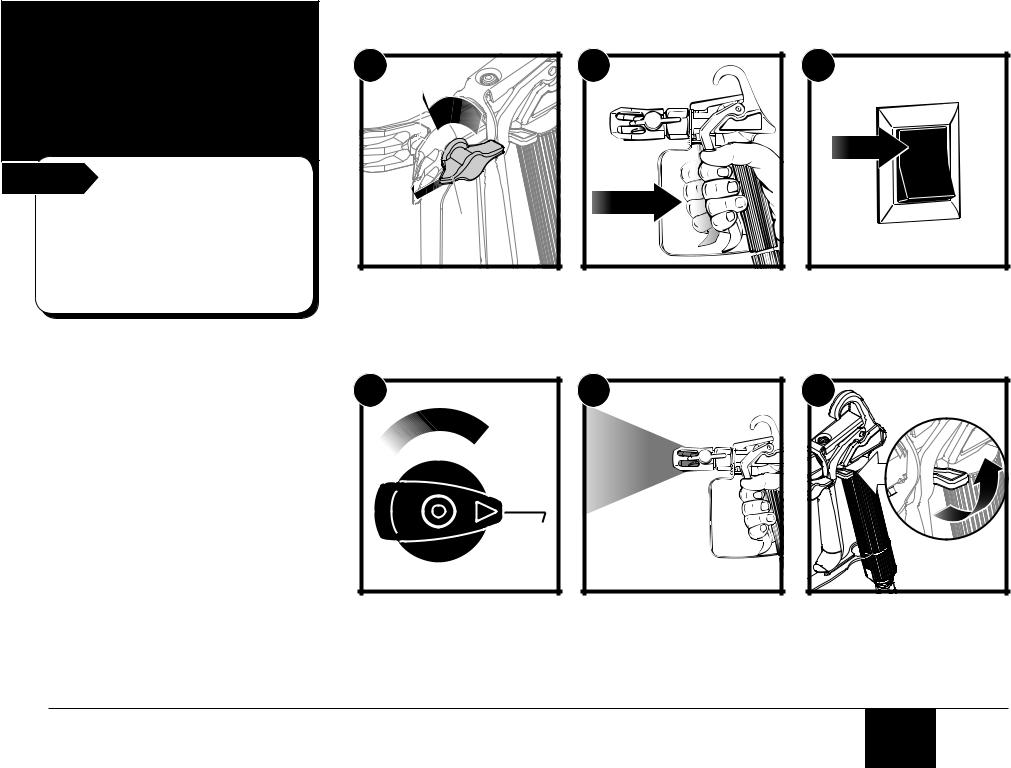
3. Getting |
1 |
||
Material to |
|||
|
|||
Flow |
|
||
Start |
You will need: |
|
|
• Scrap material / cardboard |
(a) |
||
• Drop cloths to protect floors and |
|||
furnishings from overspray |
|
||
Note: Motor will cycle ON and OFF while |
|
||
spraying to regulate pressure. This is normal. |
1. Rotate spray tip forward to |
||
|
|
SPRAY position (a). |
|
|
|
Unlock the spray gun trigger. |
|
2 |
3 |
|
|
ON |
l |
|
|
|
SQUEEZE |
|
|
2. Point the spray gun at a piece |
3. Turn the power ON. |
of scrap material/cardboard. |
|
Squeeze and hold trigger for steps 3-5.
4 |
MAX |
4.Turn the PRIME/SPRAY knob to SPRAY - maximum pressure.
5
SPRAY
5.Continue to squeeze trigger until the material is flowing freely through the spray gun.
Note: Motor will cycle ON and OFF while spraying to regulate pressure. This is normal.
6 |
6.Release the trigger and lock the spray gun.
9 |
English |
|
